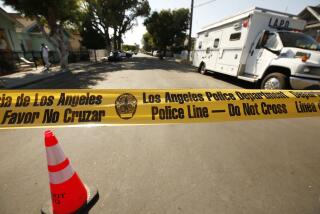U.S. Reduces Threat Level for Terrorist Attack
- Share via
WASHINGTON — Three weeks after putting the country on high alert for fear of a possible Sept. 11-style attack, Homeland Security Secretary Tom Ridge lowered the national terrorist threat level Friday -- with a cautionary word.
With the holiday season over and intelligence indicating a “diminished” likelihood of attack, Ridge announced that officials had decided to lower the threat index to yellow from orange. On the government’s color-coded scale, yellow indicates an elevated, rather than high, prospect of terrorist attack.
But while the terrorist threat has eased, Ridge said, the risks of attack remain significant. So he ordered that selected cities continue to take precautionary measures. He declined to provide details, although officials at Los Angeles International Airport said they intended to retain indefinitely the security upgrades adopted last month.
The downgrade caps a season marked by anxiety and debate about antiterrorism policy for the United States and its allies.
Ridge placed the nation on a code orange alert -- the second-highest level -- Dec. 21 out of concern that terrorists were planning to attack commercial airliners or large public gatherings over the holidays, including Los Angeles-bound flights from Paris and Mexico City.
Among the evidence he cited: an unusually large and specific volume of intelligence picked up through electronic intercepts and human sources, foreshadowing the possibility of a multipronged strike in the vein of the Sept. 11, 2001, assaults on the Pentagon and the World Trade Center.
Ridge said Friday that while officials remained concerned, especially about “persistent and consistent reports” that terrorists remained interested in using commercial aircraft as weapons against U.S. interests, the threat environment had become less acute, warranting a reduction in the terrorism index.
“We are still concerned about continued threats, but the threat conditions that we’ve been following have diminished,” Ridge said. “With the passing of the holidays and many large gatherings that certainly occur during this time, we have made the decision to come down to yellow.”
Without providing specifics, he added that “certain locales” were being asked to continue security enhancements on a targeted basis.
For example, at LAX -- designated the state’s No. 1 terrorist target last year by the California attorney general’s office -- officials said they intended to retain the security upgrades made on Dec. 21.
Airport officials said there was no “end date” for tightened security and that a decision to keep LAX on a heightened alert was based on specific intelligence. Added security is expensive for the city of Los Angeles, which has been spending $100,000 a day at LAX as a result of its orange status, mostly on overtime for additional police patrols.
Travelers at LAX will notice several of the additional security measures required under orange, including checkpoints at major roads leading into the facility, more police patrols in the airport’s nine terminals and along its horseshoe-shaped roadway, and more canine patrols on LAX grounds. Los Angeles World Airport’s other facilities, Ontario International Airport and Van Nuys and Palmdale airports, will revert to security required during a yellow alert.
The decision to raise the threat level led to more than 12 international airline flights being canceled or delayed, including several along a popular Paris-to-Los Angeles route. It also prompted the FBI and its foreign partners to scour passenger lists and run down travelers with names similar to or matching those on a government list of suspected terrorists. The U.S. military deployed F-16 jets to shadow certain commercial flights, and foreign carriers were ordered to place armed sky marshals aboard certain flights.
Ultimately, they all came up empty-handed. This week, federal investigators concluded that no passengers on a canceled Air France Flight on Christmas Eve to Los Angeles, which intelligence had singled out as a possible target for being commandeered and used in an attack, had posed a danger.
The three-week orange alert also was marked by tension between the U.S. and allies over whether U.S. officials were adequately sharing the information they had for delaying or canceling flights.
Ridge said he had recently met with representatives from France, Britain, Spain and Mexico as a first step in establishing “a better protocol” to handle threat information affecting international flights.
“Not in any way are we apologetic for what we’ve done,” he said. “But now, going ahead, there’s a growing awareness in the international aviation community that we need to establish standards by which we can deal with this kind of threat information.”
Ridge said the fact that no arrests were made during the heightened alert was a sign of vigilance, and he indicated that the stepped-up security efforts and public awareness might have scared off or dissuaded potential attackers. He didn’t provide any hard evidence but said the government had learned of other terrorist plots that had been disrupted or aborted as part of debriefing suspects in other cases.
The decision to raise the threat level was the fifth time it was boosted to orange since the system was deployed in 2002.
*
Schmitt reported from Washington and Oldham from Los Angeles.
More to Read
Sign up for Essential California
The most important California stories and recommendations in your inbox every morning.
You may occasionally receive promotional content from the Los Angeles Times.













